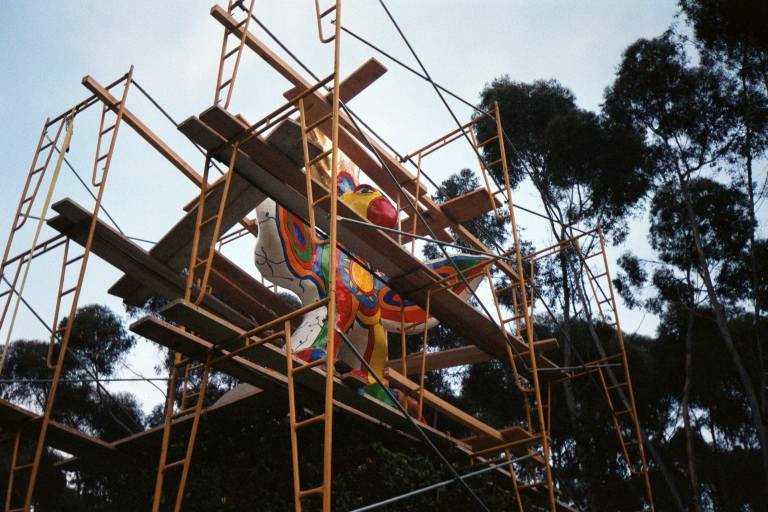
Scaffolding is in place around the Sun God sculpture at UC San Diego at some point during my time there before 2001.
Author’s note: I started writing this in the spring of 2012, the last time UC San Diego students voted on whether to move to NCAA Division I (it failed with 56.7 percent of students voting no). It’s unfinished, but I’m finally publishing it because students will again vote on D-I this spring. Aside from modifying the original headline (from “UCSD’s possible Division I move won’t bolster school spirit alone”), everything else is presented as-is from four years ago. I’ll definitely have more thoughts in the weeks to come.
UC San Diego’s possible move to NCAA Division I has been on my mind since the student vote started last week. The proposal has stirred deep concerns, but I sort of didn’t want to speak out about it. While I have strong spirit for UCSD, it’s not really my opinion that matters — it really boils down to the current students and what they want.
After doing some research and witnessing a relatively small crowd watch the women’s basketball team in the playoffs (at a tournament UCSD was hosting), I’ve concluded that D-I likely won’t accomplish what proponents say they want — an increase in the campus’ prominence, a bolstered campus life and a more involved alumni community. At least not alone.
Ultimately, having students each pay nearly $500 more per year for Division I seems pound foolish without a concerted effort to pursue complementary, pennywise solutions.
Campus prominence — This is a tempting lure. After all, at D-I, there’s always the possibility of the men’s or women’s basketball teams making it to March Madness. And for 21 other sports that struggle for the spotlight, there’s the ability to play slightly bigger rivals. And think of all the other Division I programs that you can name.
Unfortunately, campus prominence seems like a tease. There are 346 D-I schools. Name recognition gets sketchy after the 47th team in a basketball tournament or the two teams facing off in a 35th-tier football bowl game sponsored by a bail bondsman.
Other schools have made the argument that D-I would bolster their regional and national appearance. When I was going to school, UC Riverside students made that argument when voting to go to Division I in 1998.
Does the fact that UCR is now D-I really improve that campus’ reputation in your mind? The same argument could be made for UC Irvine and even UC Santa Barbara (outside of their basketball team, at times). These are schools known largely for things other than their athletic legacy.
Proponents also assert that UCSD has outgrown D-II after 12 short years, arguing that the school is too big for its conference, the California Collegiate Athletic Association, in both student population, academic prowess and athletic performance. I’m not too concerned about campus size or scholastic performance, but there’s still room to grow athletically.
Yes, UCSD excels in the conference, but it has earned three national team championships in Division II in 12 years, according to NCAA stats. Compare that with the 20 team titles UCSD won in Division III (where UCSD clearly exceeded average school size and dominated the division).
If UCSD goes to D-I, I predict its prominence will still languish on regional and national stages. Locally, UCSD would still be in third position — behind San Diego State University and University of San Diego. (USD is another example where a school’s D-I status is relatively unimportant — except for Jim Harbaugh for football and a rare March Madness basketball win.)
If UCSD were an athletic Goldilocks, Division III was obviously too small, Division I is likely too big, while Division II is still just right.
Improved campus life —
